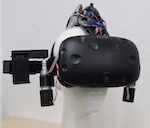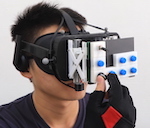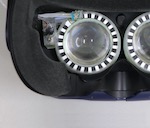HMD+
Exploring Haptic Feedback on VR Head-Mounted Displays
Haptic feedback is indispensable to everyday tasks, from tapping on a smartphone to crafting woodwork. Such an essential sense, however, is limited to vibrotactile feedback in most VR experiences, usually enabled by hand-held controllers. Although many researchers have designed haptic devices in HCI and VR, they often focus on the hands. We aim to enable haptic input and output through Head-Mounted Displays (HMDs) to explore haptic feedback on the face.
FacePush

FacePush induces haptic feedback as output on the face through a pulley system using motors on the HMD. We implemented three applications to demonstrate FacePush: providing feedback when getting punched in a boxing game, simulating water currents on the face while swimming, and indicating where to look in a 360\(^\circ\) video.
FaceWidgets
Installing physical controls, such as buttons and joysticks, on the HMD to support tangible input in VR.
Fun Facts
- Many thanks to the support of my labmates (Hong-Yu, Chia-En, Yi-Chen, Li-Yang, Chiu-Hsuan, and many others) in Taiwan and the HCI knowledge from Liwei.
- Jan shared the same interest of putting stuff on VR headsets. With Samuel, we worked together as supervisors and PhD student but on a completely different topic (see my PhD thesis)!
Powered by R Markdown. Inspired by LabJournal, privefl, and holtzy. Hosted by GitHub. Copyright © Wen-Jie Tseng 2025.

